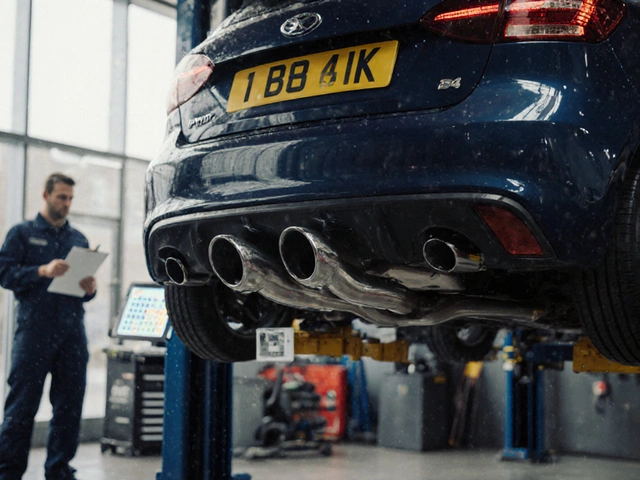Keeping an eye on your engine oil is like ensuring your body stays hydrated. Just as water keeps you going, oil ensures your car's engine stays smooth and efficient. Many people tend to overlook this vital aspect, not realizing the potential damage lurking beneath the hood when oil levels dip too low.
Low engine oil isn't just a simple inconvenience – it can lead to significant, costly repairs. An engine without enough oil is like a heart without enough blood – the gears and parts inside can wear out quicker and lead to a complete system failure. Understanding the importance of maintaining proper oil levels can save you from unexpected breakdowns and keep your car running longer.
In this article, gain insights into why oil levels are crucial, recognize the warning signs that indicate a problem, and discover actionable tips to keep your car in top shape. When it comes to vehicle care, knowledge is power – and we're here to empower you with the information you need to avoid being stranded on the side of the road.
- Why Oil Levels Matter
- Signs of Low Oil
- Consequences of Low Oil
- Tips for Maintaining Proper Oil Levels
Why Oil Levels Matter
The importance of engine oil in your vehicle cannot be overstated. It serves as the lifeblood of your car's engine, performing several crucial functions that maintain your car's performance and health. At its core, oil is responsible for lubricating the various moving parts within the engine. These parts, such as pistons, camshafts, and bearings, require a thin film of oil to reduce friction as they move at high speeds. Without sufficient lubrication, these metal components can grind against each other, leading to wear and tear or even permanent damage. This damage can result in costly repairs or, in worst-case scenarios, the failure of the entire engine.
Beyond lubrication, oil plays an essential role in cooling the engine by carrying away the heat generated by combustion and mechanical processes. As oil circulates, it absorbs heat from the engine parts and dissipates it, preventing overheating. Additionally, engine oil acts as a cleaning agent. It traps soot, debris, and other particles that accumulate over time, preventing them from causing blockages or damage. Regularly checking your oil levels ensures that your car can effectively use its oil to clear these impurities. It's akin to your body's own waste management system, ensuring that harmful substances don't accumulate to dangerous levels.
Maintaining the right oil level ensures efficient fuel consumption. When there's insufficient oil, the engine must work harder to perform its tasks smoothly, leading to higher fuel consumption and emissions. For those conscious of their environmental footprint, keeping oil levels in check is an easy way to minimize your impact. A well-lubricated engine runs more efficiently, consuming less fuel and producing fewer emissions. Industry experts consistently emphasize its significance. As the late automotive expert Lee Iacocca mentioned,
"The engine is the heart of any car, and the oil is its lifeblood."This metaphor underscores the vital nature of oil in maintaining your vehicle's overall health.
Moreover, knowing the right type of engine oil for your vehicle and observing recommended intervals for checking oil levels can save you headaches down the road. Modern engines have specific oil requirements, often dictated by the car manufacturer. Understanding these requirements not only extends the life of the engine but also enhances its performance. Choosing the wrong oil type or neglecting to change it can undo all the benefits the oil should provide. This highlights the importance of routine maintenance. A simple action like checking oil levels can prevent common but avoidable issues. It's not just about keeping your car running—it's about keeping it running efficiently and reliably.

Signs of Low Oil
Recognizing the signs of low engine oil early on can save you a heap of trouble down the road. One of the most apparent indicators is the oil pressure warning light illuminating on your dashboard. This light is not just for decoration; it typically means that your engine’s lubrication system is in distress. When the oil levels are not enough, the pressure drops, causing the light to engage and alerting you to take action. Another sign to watch for is the unusual knocking or clattering noise coming from under the hood. This sound often results from the moving parts in the engine not being properly lubricated, leading to increased friction and wear.
Your vehicle’s performance can also change if it's running low on oil. You might notice that your engine feels less responsive or has difficulty accelerating. This decrease in performance might not seem drastic at first, but over time it can seriously impact your vehicle’s ability to function efficiently. A burning smell is another red flag; this occurs because the remaining oil is overheating as it struggles to cope with the demands of the engine. Such conditions can lead to the oil burning up, and you might even see smoke coming from the exhaust or under the hood, an unmistakable cue that your engine is suffering.
The dipstick is your friendly neighborhood detective when it comes to checking oil levels. It’s a simple yet effective tool you can use to gauge the situation. Many drivers forget about this handy device. Regularly examining the color and level of the oil on the dipstick can prevent issues. Fresh oil should be amber and clean, but as it gathers dirt and tiny bits of debris, it turns darker. If the oil level is noticeably below the minimum mark, it's time to top it up. And if performance issues persist despite maintaining oil levels, it might indicate a leak.
Among these signs, perhaps Henry Rosenbaum, a renowned automotive engineer, put it best:
"The life of an engine lies in its lubrication and neglecting that is akin to inviting undue wear that could otherwise be easily prevented with regular checks."This speaks volumes about the importance of vigilance when it comes to car maintenance. Industry experts suggest that a regular oil check, at least once a month, can go a long way in ensuring your engine's longevity.
In essence, staying attuned to these symptoms is vital not just for the health of your vehicle, but also for your peace of mind. Addressing oil level issues proactively can circumvent a myriad of engine problems and ensure fewer trips to the mechanic, leaving you with more time to enjoy the road.

Consequences of Low Oil
Driving with low oil is more than a slight misstep in car maintenance; it's a risk that can lead to a series of escalating mechanical issues. The engine, often described as the heart of your vehicle, depends on a steady flow of oil to function optimally. Oil acts not only as a lubricant but also as a coolant and cleaner. When there's not enough oil, friction between the various components increases, causing them to wear out faster. This might start as a minor issue with a few worn-out components but can quickly progress to a major failure if left unattended.
Imagine running a marathon without access to water; your performance would dwindle, and your health could be at serious risk. Similarly, without enough oil, your engine may overheat and seize up. This overheating can lead to a blown gasket, which is often a costly and time-consuming repair. In extreme cases, an engine operating with insufficient oil levels can break down entirely. This doesn't just result in a stranded vehicle but also escalates repair bills that could have easily been avoided. It's not uncommon for mechanics to trace engine failures back to neglected oil upkeep. As one seasoned mechanic once put it,
"An engine without oil is like a ship without a compass - it's bound to get lost and cause trouble."
Worn engine parts due to insufficient lubrication are a common cause of decreased fuel efficiency, meaning you'll be spending more at the pump despite the engine working harder. Additionally, engines running low on oil tend to produce more emissions, which could cause a car to fail an emissions test, leading to legal penalties in some regions. The environmental impact is another facet to consider; improperly maintained engines can release more pollutants into the atmosphere, becoming a small cog in the larger machinery of environmental damage.
Regular oil checks and changes are key to preventing these scenarios. It's advisable to keep track of your vehicle's mileage and stick to a maintenance schedule for oil changes - typically every 3,000 to 5,000 miles, but always refer to your car's manual for specific recommendations. Understanding the pivotal role oil plays in your car's performance helps underscore the importance of maintaining adequate levels, turning this simple task into a worthwhile routine. An informed car owner is always a step ahead in safeguarding their vehicle's wellbeing and efficiency, avoiding pitfalls that come from neglect.

Tips for Maintaining Proper Oil Levels
Keeping your car engine healthy involves regular monitoring and maintenance of its engine oil. Simple steps can ensure that your vehicle stays in top form, preventing unexpected breakdowns or costly repairs. Start by making a habit of checking your car's oil level regularly. Ideally, you should check the oil at least once a month. This can be done at home with just a paper towel and a good old-fashioned dipstick.
First, make sure your car is parked on level ground and that the engine is cool, so you get an accurate reading. Remove the dipstick, wipe it clean, and then reinsert it fully. Pull it out again, and check the level against the markings. If the oil level is between the 'Min' and 'Max' markers, you’re good to go. If it's below the 'Min' marker, you'll need to add oil.
Using the right type of oil is crucial. Consult your car’s manual to determine the recommended viscosity and type for your vehicle. Using the wrong type can be just as harmful as running low. Most automakers recommend synthetic oils due to their enhanced properties over conventional oils, including better protection, improved performance in extreme temperatures, and a longer lifespan.
“Regular oil changes are the best preventative maintenance the average consumer can do to protect their investment in their vehicle,” says John Banta, an automotive expert from Consumer Reports.
Ensuring that oil changes align with the manufacturer's schedule is another key step. While the old rule of thumb was every 3,000 miles, many of today’s cars can go between 7,500 and 10,000 miles between oil changes. Regular oil changes flush out contaminants and keep the engine running smoothly.
| Typical Oil Change Intervals | Conventional Oil | Synthetic Oil |
|---|---|---|
| Mileage (Miles) | 3,000 - 5,000 | 7,500 - 10,000 |
If you notice signs of low oil, such as the ‘check oil’ indicator lighting up, strange noises from the engine, or an oil smell inside the car, take action immediately. Adding oil can be a temporary fix, but it’s best to have your car checked by a professional to rule out major leaks or other issues. These practices may seem like common sense, but they can significantly extend your car's lifespan and avoid engine oil-related problems down the road.
Don’t hesitate to engage with your service provider to ensure that everything is running smoothly, and ask questions if you're unsure about what is required. Maintaining your own car can feel empowering, and over time, you'll understand its quirks and needs. Proper car maintenance is an ongoing commitment, but it pays off with reliability and peace of mind.






